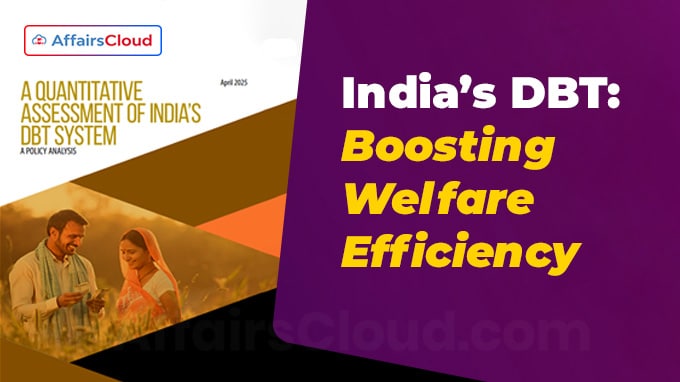 India’s Direct Benefit Transfer (DBT) system has helped the country achieve cumulative savings of Rs.3.48 lakh crore by minimizing leakages in welfare delivery, according to a new quantitative assessment by New Delhi(Delhi) based BlueKraft Digital Foundation.
India’s Direct Benefit Transfer (DBT) system has helped the country achieve cumulative savings of Rs.3.48 lakh crore by minimizing leakages in welfare delivery, according to a new quantitative assessment by New Delhi(Delhi) based BlueKraft Digital Foundation.
- The report also states that subsidy allocations have been halved from 16% to 9% of total government expenditure since the implementation of DBT.
- The findings, supported by the Ministry of Finance(MoF), underscore DBT’s transformative effect on enhancing public spending efficiency, streamlining subsidies, and advancing social inclusion.
About the assessment:
i.One of the key features of DBT is the use of the JAM trinity, which stands for Jan Dhan bank accounts, Aadhaar unique Identification(ID) numbers and mobile phones.
ii.The assessment evaluates data from 2009 to 2024 to examine the impact of DBT on budgetary efficiency, subsidy rationalisation, and social outcomes.
Key Findings:
i.Pre-DBT Era (2009–2013): In this era, subsidies accounted for 16% of total expenditure, amounting to Rs.2.1 lakh crore annually, but the system suffered from considerable leakages.
ii.Post-DBT Era (2014–2024):Subsidy expenditure decreased to 9% of total expenditure in 2023-24, while beneficiary coverage increased 16-fold from 11 crores to 176 crores.
iii.COVID-19 Outlier: There was a temporary spike in subsidies during the 2020–21 fiscal year due to emergency fiscal measures.
Sectoral Analysis:
The following sector-wise breakdown shows DBT’s major impact on high-leakage programmes
i.Food Subsidies: Rs.1.85 lakh crores was saved, accounting for 53% of total DBT savings.
ii.MGNREGA(Mahatma Gandhi National Rural Employment Guarantee Act): 98% of wages were transferred timely, saving Rs. 42,534 crores through DBT-driven accountability.
iii.PM-KISAN (Pradhan Mantri Kisan Samman Nidhi): Rs. 22,106 crores were saved by deleting 2.1 crore ineligible beneficiaries from the scheme.
iv.Fertilizer Subsidies: Targeted fertilizer disbursement saved Rs. 18,699.8 crores.
Correlation and Causality Findings:
The analysis clearly shows that DBT has helped make welfare delivery better.
i.Strong Positive Correlation (0.71): There is a strong positive correlation between beneficiary coverage and DBT savings, signifying a coverage expansion and savings increment.
ii.Negative Correlation (-0.74): There is a significant negative correlation between subsidy expenditure as a percentage of total expenditure and welfare efficiency, highlighting the reduction in waste and leakages facilitated by DBT.
Welfare Efficiency Index (WEI):
i.The report introduces a WEI, an index that combines fiscal outcomes such as savings and reduced subsidies with social indicators like the number of beneficiaries reached.
ii.The WEI comprises three weighted components:
| Component | Weightage (in %) | About | Note |
|---|---|---|---|
| DBT Savings | 50 | This component captures the direct reduction in leakage. | Rs. 3.48 lakh crore cumulative leakage reduction. |
| Subsidy Reduction | 30 | Measures the decline in subsidy expenditure as a percentage of the total national budget. | A decline from 16 percent to 9 percent of total expenditure. |
| Beneficiary Growth. | 20 | Assesses the expansion in the number of beneficiaries, adjusted for population growth. | A 16-fold expansion in coverage. |
iii.The index has risen nearly threefold from 0.32 in 2014 to 0.91 in 2023, reflecting systemic improvements.
Recent Related News:
Pradhan Mantri Shram Yogi Maandhan (PM-SYM) Yojana, a landmark initiative led by Government of India (GoI) which aimed to provide financial security to millions of unorganized workers in India. It is a part of the GoI’s wider social security initiatives and aligns with the vision of universal pension coverage for workers in the unorganised sector.
- The scheme ensures a minimum pension of Rs 3,000 per month after the age of 60 for workers who are employed in the unorganised sector and have a monthly income of up to Rs 15,000.




